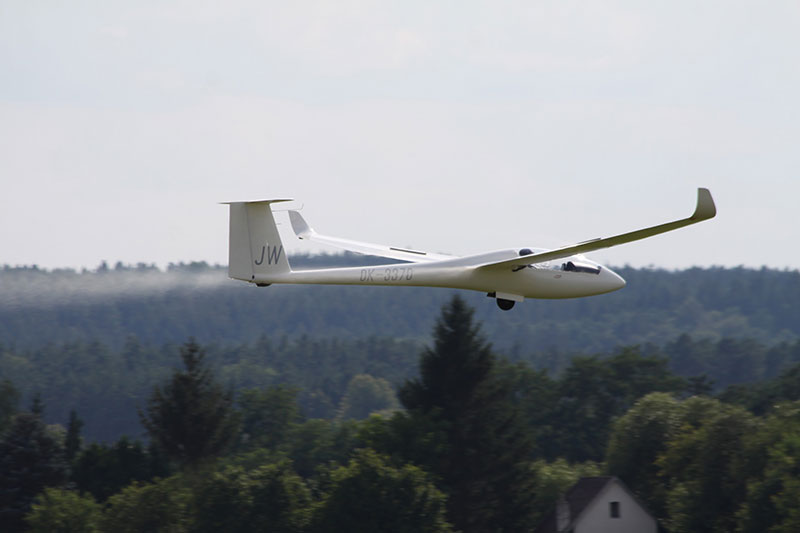
Ryan Driscoll looking optimistic on the grid.
By James Nugent
Normally after a competition I find myself eager to jump on the computer, coffee in hand, and jot down my experiences, frustrations, celebrations, and what I learned. However, after arriving home from the Czech Republic, I have to say that it was a chore. The championships were years in the making, I threw (almost) everything at it, and by the time the FAI flag was lowered we were reeling and healing from the events that were the 12th FAI Junior WGC.
Ryan Driscoll and James Nugent.
In late 2018, the successful bidder to host the 12th FAI Junior World Gliding Championships (JWGC) was announced as Tàbor Aeroklub, Czech Republic. This was exciting news for keen junior pilots who were accustomed to fast flat-land racing, as the site was regarded as being hotter, higher and flatter than the alternatives. I put plans in place to maximise my qualifying chances, intent on securing a first-place selection. This included acquiring and setting-up a competitive club class glider, and practising as much as studies, work and finances allowed.
Commitment Issues
The COVID-19 pandemic arrived, and all world championships scheduled for 2021 were delayed until 2022. Additionally, the age limit for a ‘junior’ was raised from under-26 to under-27 for this championship only. Unfortunately, the 12-month delay now meant that the Tàbor championships would be the last that I would be eligible for. The increase in age limit also meant that some very experienced pilots were now eligible to compete once again. On the bright side, the advantage of having more time to prepare was the same for everyone, and I considered it important to make the most of it. Arguably, these decisions led to this JWGC being described as the most competitive JWGC in a decade. 
The team gathered at the opening ceremony - pilots Ryan and James joined by Russell Edwards, Joe O'Donnell, Andy Horton and Noah Tanzen.
Fast forward to the start of 2022 and it was time to commit to the trip or otherwise. At this stage, alleged new COVID strains were still appearing, people were still getting sick, and most importantly, Russia was making moves in Ukraine. Paying the entry fee was one of the most difficult decisions I have made as the circumstances were extraordinary. By this stage, Ryan Driscoll had also qualified to come along, and we had several long phone calls in an attempt to decide what to do. The devastating reports out of Ukraine – less than 500km away from the task area – made the decision that much harder.
Probably against most people’s better judgement and the information available at the time, I decided to submit my entry. On the same night, I booked accommodation, confirmed a car and glider, lodged some documents with CASA, and ordered assorted items needed for the trip. I had to try very hard convince myself that I was going!
Planning
We decided early in the planning to seek gliders with maximum performance. The thinking behind this was that more performance could be used to help cover mistakes in unfamiliar territory. Additionally, Ryan had been spending a lot of time flying Open Class and it can be difficult to go backwards in performance, as they say. Neither of us had flown ASW20s, and efforts to find two solid LS3s were unsuccessful. Given the reputation of the Discus 2a as difficult to tame without practice, we decided that it would have to be two LS8s flying in standard class. Through an old friend, I managed to source a beautifully refinished LS8neo from the UK, and I was incredibly happy that I had the perfect tool for the job – all I had to do now was focus on the pilot.
The paperwork to make the pilot legal was exhausting. Ryan and I were the first to discover that the well‑trodden path used by Australian glider pilots to obtain foreign aviation medical certificates was no longer an option. We hustled and thought outside the box in attempts to get around this problem, while managing several other problems along the way. For several weeks, I would arrive home from the office, to go straight to the home office, to do several hours of paperwork. Preparing for a world comps abroad was truly a huge effort.

Gliders landing after a difficult day.
Several weeks out from departure, I got word that the owner of my glider had a change in circumstances and had to sell the beautiful LS8neo that I was planning to fly. While devastated, I quickly shopped around for alternatives. The glider search was made challenging by licensing limitations and clashing competitions, such as the WWGC in the UK. I eventually locked in another LS8, after doing the best background research I could, hoping that I would not regret it. Where our fellow competitors from Europe would have been able to call on a network of friends to get them out of similar jams to what we were having, I felt that we were falling victim to both geography and language. On a positive note, all the (very delayed) paperwork necessary for both Ryan and I to fly legally arrived just in time, as we worked through some final challenges - like Ryan losing his crew – twice.
As the A380 turned westbound, I felt organised, but genuinely depleted. We had been practising at every opportunity, chasing paperwork for months, managing relationships and expectations, dealing with last-minute cancellations, and counting on people to come through for us. I had also been working hard in the lead up to going on leave. I mentioned to some people that moving the stick was going to be the easy part - and I was not joking.
The Aussies Have Arrived
We were the first full team to arrive on site at Tàbor and quickly got to work securing the best tie-down spot for the gliders, and the best campground location for Aussie Base. The reason for arriving on site so early was simple – neither Ryan nor I had flown in Europe before, and we had to work with the limited time, money and annual leave budgets that we had. I can only assume that there were other teams flying from sites not too far away - though we never managed to find them on OGN.
Opening our glider trailers for the first time was a nervous moment. As the owner lifted the lid on my LS8, the first thing I saw was the state of the gelcoat on my rudder - it was cracked and flaking off. I knew immediately that my aspirations for the competition had just taken a hit. Searching further around the airframe did not help, to the extent of Matt Scutter suggesting that he could have stubbed his toe on my spar bump. Obviously, by this stage, I was very committed to this glider. It became a matter of working with what you have. Unfortunately, tweaking the glider during the practice period drew far more energy from me than I would have liked. I managed to correct a mis-trim by intentionally flying out of balance laterally. We managed a badly leaking tail tank, and on each flight I was running out of battery power. The list goes on! Some people claim that deficiencies in gliders make a small difference in the grand scheme of things, and they might be right in some cases. However, what it does to a pilot is make them feel that they need to ‘overfly’ the glider to compensate for the deficiencies. It is possible that this was affecting my attitude or ‘flow’ during the competition. A walk of the grid to see my fellow competitors in their own (very nice) machines did not help, and neither did the first few glides with them. Fortunately, the owner was fantastic in helping to work through issues such as the batteries, so thank you to him.
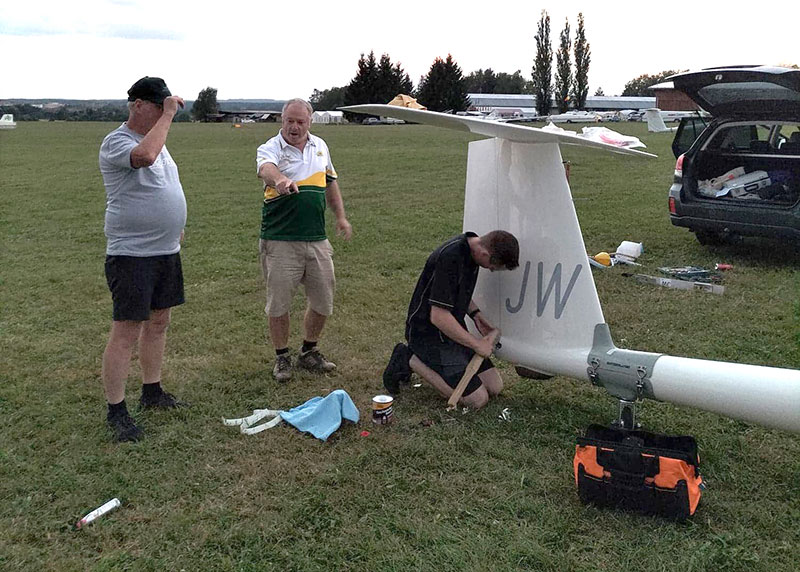
Pilot and crew get to work repairing the LS8.
So how was the flying?
During the practice period, we got the full spectrum of Czech soaring conditions in about 5 days. One day was completely blue and most of our fellow competitors did not venture far from the field. Granted, it was only practice, but this suggested to us that they genuinely were quite uncomfortable in the blue conditions. We identified dry or fully blue days as advantageous for us and hoped for just a few during the competition…
We also got a day of classic cumulus racing, a cold front day, a day with classic European overdevelopment, and a day that was wiped out by high-level cirrus. While this was good practice for the competition, there were also a few surprises that cast some doubt in my mind about the conditions.
Perhaps the biggest thing I took away from our week of practice was how defensive flying in Europe was, even if the forecasts were theoretically as strong as ours. In Australia, we regularly fly the track line until we need to fold and divert to trigger points. In Europe, the default was to track for the nearest line of energy, deviating as required to use it. This ensures that you stay high and maximise available climbing options – because often you’ll need more options.
The Big Dance
Day 1 dawned, and after a day off for the opening ceremony I was feeling refreshed and excited. At the last JWGC I flew, we were flying on our own soil and felt some pressure to perform. By contrast, the morning of Day 1 as an Australian flying in Europe was very different.
The day served up some classic European low-level cumulus conditions, with cloud base just over 3,500ft AGL and widespread areas of spread-out. This forecast could easily be considered a threat for an Australian, but armed with my new flying style of rapid and smooth deviations, I was focused, relaxed and flying well.
I was by no means connecting with strong climbs out of the weeds, but often when I found myself cruising low into a bad part of sky, I was in the company of a very good pilot, when and where I needed to be. For the second half of the task, I was able to form a fast-running mini gaggle comprising of two Dutch, a German and a Hungarian pilot that worked very effectively. We made excellent pace through to the final 60km.
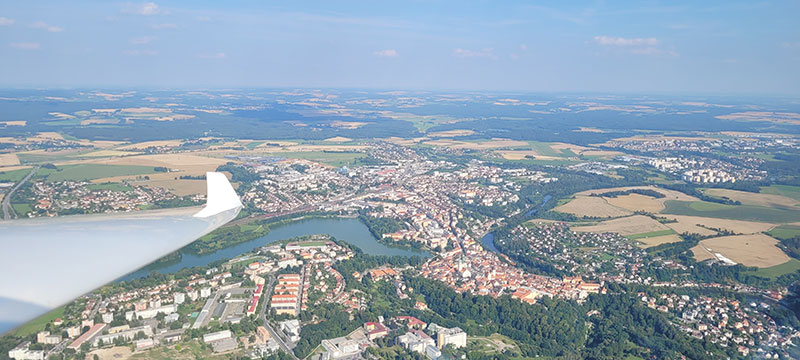
Flying over Tàbor city.
Approaching the final turnpoint, it was clear that the next leg had some mild overdevelopment to be negotiated. “No problem,” I thought, as there were several reasonable clouds enroute, and I was armed with the mini-gaggle. First, second and third clouds did not produce, and I threw some searching turns to allow the other pilots to arrive on the scene. Departing the third cloud we were faced with a decision – glide slowly on track, through the mild overdevelopment to arrive over the sunny forests on the other side, or fold completely, and continue directly through the turnpoint to where there was a glider climbing in 2.5kts on the other side, drifting downwind. The six of us cruising together all went for the first option, likely each considering the probability of someone connecting with better than 2kts to be quite high.
The gaggle cruised around the turn point and we each spread out across the overdevelopment. We cruised on and on and on, finding absolutely nothing! Despair eventually turned to desperation at 800ft AGL, as wings and water went everywhere. The glider turning the steepest saw everyone swarm – even if it was only 0.2kts. The emotions would have been boiling in each of these cockpits. A group of pilots from all over the world had been working together beautifully all day, and each of us were one top-up away from a perfect flight to open our accounts. Now we were wrestling to not be the first glider to drop into the field below!
I eventually assembled a final glide from the ruins that was my flight and flew home, desperate to get out of the cockpit and away from the place. While my position on the score sheet seemed reasonable, several pilots did get home unscathed and therefore enjoyed a huge points reward - well done to them.
Tasking
Even before the competition started, the organisers were clear in publicising the fact that they would be looking to set fixed racing tasks as much as possible. I believe the reasoning provided was that they were concerned that luck would play a larger role in assigned area tasks (AATs). Throughout the competition, many of the experienced pilots and team captains raised concerns about relying on fixed racing tasks, since sizeable proportions of the fleet were consistently finding themselves in the same part of sky at the same time. Unfortunately, some reinforcement for the AAT and luck theory came on Day 2, which played a role later in the competition.
The day was forecast to overdevelop badly with potentially large areas of rain and associated gust fronts and convergences. The forecast for rain did not eventuate, however the convergence forecasts certainly did. Towering cumulus streets aligned themselves with the wind alongside areas of overdevelopment. If you were able to ‘hook up’ a convergence line and run it while it was sucking, then you had an exceptionally fast day. If you were unable to because you were in the wrong place at the wrong time, then you had a horrendous day in windblown and broken thermals, lacking the time and range to correct the situation all day.
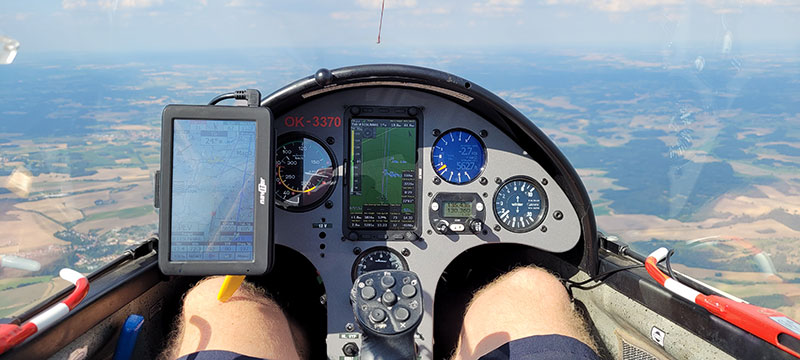
View from James' cockpit.
Ryan and I both found ourselves on the interior of the two convergence systems, separated by 5 to 10 minutes after I turned a bit deeper in the first sector. Fortunately, Ryan was able to make reasonable use of the convergence, being slightly earlier, but I got the absolute dregs. The system disintegrated unceremoniously and the struggle got worse and worse, to the point where I had to bounce off the ground in 1 to 2kts - twice. I think both of us were cognisant to the fact that the pumping convergence system was 15km to the north of us, and that our fellow competitors were testing the speed of sound while they used it. A big part of our sport is working with the conditions you are given, and I put my head down to focus on leaving the area as soon as possible – maybe the day had another twist in it?
Some time later, I finally climbed into a position where I could make the transition over to the north to connect with the better convergence system. Once connected and cruise-climbing at 110kts at cloud base, I could have been sick with how disappointed I was. I knew that my fellow competitors had been using this all day, and that my goals for the competition were in tatters.
First Week
The first week continued with more racing tasks and some more strong European conditions. I used Day 3 and Day 4 to settle down and find some rhythm, which I was able to do reasonably well. For the first time, I felt that I was starting to get some luck – whenever I was cruising into a slightly tight spot and half a dozen clouds hadn’t worked, I was now finding that bubble that eluded me previously. While it felt like luck, the cause was probably much more rational. Most likely it was that I was now understanding the European wind-trigger-sun-cloud relationship and was positioning the glider correctly. It is a shame this happened four days into the contest, but that’s life!
On Day 5, we got our blue day, and we were pumped. The sun was beating down on the grid and we almost felt at home. Our European colleagues were far from impressed, and many of them had clearly identified that the day was a threat and decided to fly very conservatively.
Unfortunately, Ryan and I muddled the start by activating our final PEV window several minutes too late, meaning that we had to entertain ourselves over the start gate while the fleet disappeared downrange. In some ways this might have been a blessing because it gave us several minutes to recompose ourselves after two hours of absolutely gruelling start games and gaggle flying.
Throughout the first week, the standard of gaggle flying by the Standard Class pilots was excellent. Everyone was rock-solid, allowed each other room, and mistakes were few. However, owing to the sheer quantity of gliders, the pre-start gaggles were still incredibly stressful. This was especially true when Club Class arrived on the scene and when timers were running to monitor the PEV windows.
Back to the blue flying. Ryan and I set off in pursuit of the fleet with the confidence of, well, two Victorians flying in blue conditions. We didn’t have a particularly good run, but by being focused and disciplined we started to reel in and overtake gliders. Approaching the bottom of final glide, we became separated at the worst possible time, and had to search for our final climbs independently. Both of us knew that two solid climbs would land us a good result, while one excellent climb would land us a comfortable podium. As is often the way when you are ‘overflying’ the glider, those sorts of climbs tend to elude you. We struggled home in some average late afternoon bubbles, never really climbing on to a strong final glide. Once again, I climbed out of the cockpit regretting a missed opportunity, expecting to get rinsed for my mistake. To my surprise, Joe and Andy drove up to me on the runway with big smiles on their faces. They had been watching the live scores on the tracking all day and thought that I might have secured a top 5. I explained that there must have been a mistake. Sure enough, it was P6 for my efforts, immediately behind the Germans, but a long way back from the French Trio. Ryan came home in a very solid 12th.
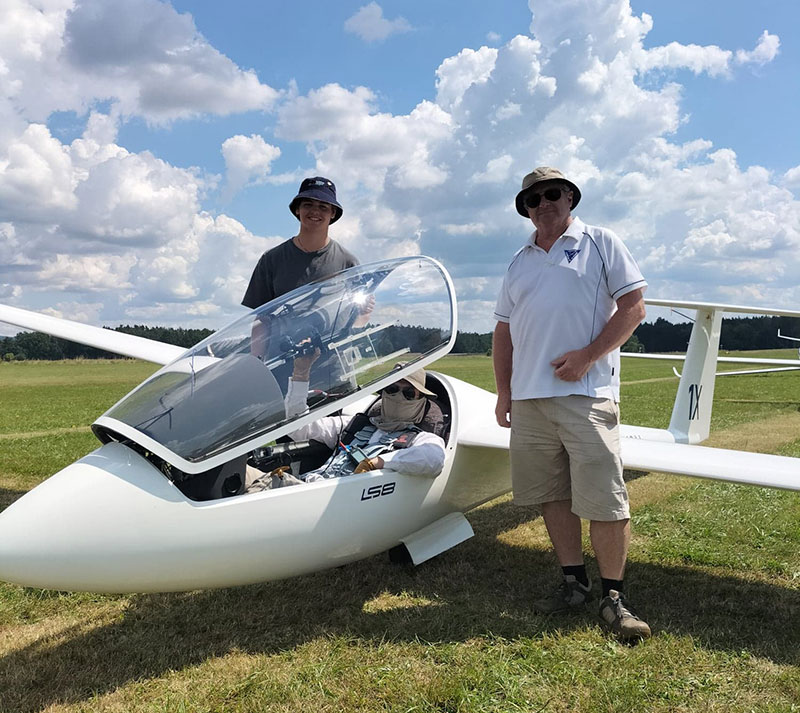
Noah, Ryan and Russell
I was surprised at how much this decent result lifted the Aussie camp. Everyone relaxed, the crews worked with purpose, and the conversation took care of itself. Both Ryan and I regretted not being able to produce a similar result on the opening days.
Day 8 was another solid result, and Ryan’s best day. We flew a clean and tactically strong flight, starting after and eventually catching the fastest gliders in the class. While on the way home to Tàbor for what would have been a podium result, I had a moment of distraction while following a glider immediately ahead, and managed to fly past the control point, losing several minutes while I returned to collect it. I was incredibly disappointed to say the least – having never overflown a turnpoint before. I managed to do it while trying to bank my best result at this world comp.
Second Week
The second week started with Czech evening, followed by two rest days. The Aussie team spent the first rest day in southern Czechia at a tourist hotspot of Cesky Krumlov. I was intentionally wandering in to as many tourist shops and attractions as possible, to keep myself as distracted from the state of my place in the score sheets. On the second rest day, Joe and I went to Prague, which was perfect for achieving this, although I cannot recommend waiting to see the Astronomical Clock strike the hour.
It was interesting to see how different pilots flew at different stages of the competition. By this stage, German Simon Briel, the French Trio and the Czech pair were putting in some very strong performances. It was clear that some other pilots with high aspirations attempted to respond, often resulting in a major mistake, possibly even an outlanding. Ryan and I focused on performing consistently, to put ourselves in a position to benefit when a top 10 pilot took a swing at the podium and missed.
To the tactical detriment of some pilots, Pilot Event Markers (PEV) were being used extensively in an attempt to manage start games. My observation throughout the competition was that they did little to help. This was likely due to the specified ‘wait time’ being too short, and the ‘start window’ time being too long. Combined with many tasks being perhaps shorter than the conditions allowed, the scene was set for some very long, very tense start games. Given the additional pilot workload required to manage the PEV windows while monitoring other gliders and communicating (often in code) with teammates, I think we still have some progress to make with the implementation of PEVs before they are a benefit to both safety and competitive fairness.
Having been out of flying at this level for several years, I was surprised at how much more gliding had become a ‘team game’. This was due to the use of live tracking. Tracking for the competition was OGN-based, which worked very well across at least 90% of the task area. The user interface was through the Glide and Seek website, with tasks simply overlaid and a scoring script running. Pilots were given the option to configure their FLARMs as they wished, provided collision avoidance functionality was maintained. Many teams, including us, accepted the potential disadvantage of appearing on the tracking (such as not enabling stealth mode) in order to benefit from our team in Aussie base quite literally steering us in to climbs. Aussie base enjoyed this immensely, and as pilots we usually always benefited from the information, especially once everyone was practised.
Mid-Air Collision - Back to the action
Day nine arrived, and Ryan and I were both keen to bank some more solid results to ensure that we remained in the mix. The organisers set a 500km fixed racing task, initially east of Tàbor, then west. Ryan and I lost some time through an area of heavy overdevelopment early in the task. Both of us then slightly mishandled the transition back into the strong convection. As a result, the fast French trio (who had started a minute behind us) slid past us some 150km into the task, but we were determined to keep tabs on them.
A good routing choice allowed us to reclaim the deficit to the French, and the five of us then cruised together towards what looked like an excellent line of energy. We hoped that this energy line/street would be our ticket to the German border, where the turnpoint of Entenbuehl was waiting. Unknown to us at the time, a very large Club Class gaggle had formed to our south-west, and this gaggle was funnelling into and out of their own turnpoint nearby.
As we arrived at the street, I immediately identified that we had a problem. The Club Class gaggle of approximately 20 to 25 gliders was now directly ahead, flying the same street on a reciprocal heading. I warned Ryan of what I saw, and quickly zoomed in the FLARM radar on both the LX9000 and Oudie for maximum awareness. The next minute or so was very tense; gently stepping left and right to avoid the oncoming gliders, while remaining as predictable as possible. I spotted several gliders far later that I would have liked in the European haze. I intentionally passed up a reasonable climb in an effort to not get eaten alive by the Club Class gaggle.
As the oncoming gliders became fewer and the stream of FLARM targets slowly subsided, I let my shoulders sink back in the cockpit – it was time to recompose. Shortly afterwards, I was met with a strong surge and cautiously started turning. Ryan joined behind and below. It was the best climb we had had that day. Thanks to its excellent feel, we had it centred by the second turn – 7.5kts and building. I scanned the area and could see the Club Class gaggle departing to the east, the French trio above, and several other gliders darting around in the vicinity. One of the gliders darting around was a glider approaching from the east, which I assumed must have been one of our Standard Class colleagues. Ryan and I continued happily climbing for several turns in what was now 8kts and building. Ryan was behind and below me - unfortunately in my blind spot at the time.
The radio suddenly crackled with the words no pilot wants to hear. I heard the startle in Ryan’s voice. I continued the turn, eyes darting everywhere. Suddenly there it was, appearing from behind my wing, the exact confronting scene you would expect to see.
I could see Ryan departing the thermal intact, and the plan view of an LS4 which appeared intact but was clearly in trouble. I observed the pilot jump safely, and plotted my escape from the area immediately.
After raising the alarm and talking Ryan down a bit, what followed was nearly 20 minutes of coordinated air-to-air visual inspections and observed functional checks of Ryan’s glider. As we descended towards minimum bail-out altitude, I really felt the weight of my words. I knew I had a huge responsibility to correctly identify and assess the damage. Fortunately, my background assisted, and we elected to outland Ryan near the town of Kladruby. Sometime later, I also outlanded next to Ryan, to assist him through what was going to be a challenging evening.
I threw open the lid and ran over to give him a hug. After collecting ourselves, I was horrified to see the extent of the damage to Ryan’s wing. The damage was at the severe end of the range I was expecting. On balance, we got the decision to land Ryan right, but the damage would not have needed to be much worse.
After being detained by the police and assisting the civil aviation accident investigators with their enquiries, we eventually arrived home at nearly 1am. While it was a day that I would not wish upon anyone, it could have been so much worse.
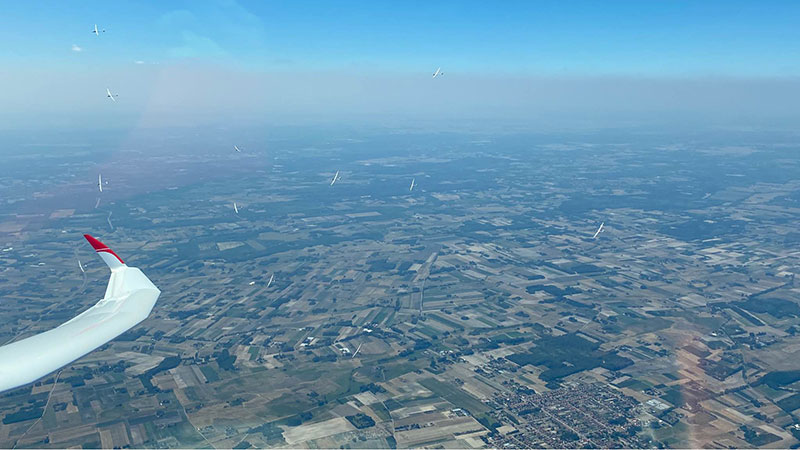
Gliders fill the sky, waiting for the start gate to open.
Home Stretch
The trip had obviously gone pear-shaped by this point, and I only had maybe an hour in the morning to decide whether to continue. I was mentally and physically spent from the day prior and expected to find it difficult to focus while in the air. However, thanks to a strong forecast and the organisers setting large assigned area tasks for both classes, I opted to get on with it and fly the next three days.
British Standard Class pilot Henry Inigo-Jones was also down a teammate, so we formed an alliance. Henry has been through the British Gliding Team system, and it shows. The way he approaches the flight is great to both work with and watch.
On Day 10, I released from tow with a clear plan to conserve energy by flying alone pre-start, only meeting up with Henry just prior to making our start. Every time there were gliders inbound for my climb, overlapping circles or gliders turning both directions, I politely made my exit. As the start gate opening time neared, I was reminded of the balance between competitive and safety risk in gliding. By actively choosing to avoid the gaggles, I found myself badly out of position pre-start, while my fellow competitors charged around at cloud base.
I eventually re-joined the gaggle for the customary start games just as the start gate opened. The next 10 or so minutes of gaggle flying saw me moving around a bit more than I normally would. The reason for this was that I was busy checking from the tip of the tail to the tip of the tail!
The first leg of the 3-hour AAT with Henry was an absolute blast. For almost the first time in the competition, pilots had a large sector, plenty of time, and a pumping sky to earn their points. After some classic cumulus racing, Henry and I found ourselves on an excellent line which carried us deep into the sector, where Henry masterfully picked his way through some overdevelopment. Before we knew it, we were careering downwind on the second leg with a task speed of over 140kph.
Day 10 was also the first day when we were tasked into the mountains. The Czech mountains are by no means the Alps, but they are comparable to parts of the Victorian high country and warrant a degree of respect. Unfortunately, our day took a turn for the worse while traversing the mountains – as I’m sure it did for everyone else, too. The third sector had been switched off by some high-level cloud cover, and this sector was positioned over a very high, very unlandable plateau.
Henry and I discussed a large excursion to remain in the soarable conditions and access the back of the sector but decided against this due to the option being high risk. The route we ultimately pioneered (and most fellow competitors followed) was a relatively direct track to collect the sector at minimum distance, followed by a careful glide clear of the plateau and clear of the mountains. This option, while popular, was fraught with inexplicable sinking air. Gliders deviated everywhere in pursuit of better, but ultimately several of us all lost our once comfortable glide clear of the plateau. Henry used a team flying term that I had not come across before, but I thought communicated exactly what it needed to – “nervous”!
We eventually struggled clear of the mountains. Too many times during this competition, during very difficult patches, I often found myself losing ground on other gliders. I attributed it to the Europeans simply being better than I was in weak, disorganised conditions. Day 10 was one of those experiences, and while Henry and I became tangled in a slow-running gaggle leaving the mountains, the German trio were able to get a wingspan clear above, and we did not see them again until the tie down area.
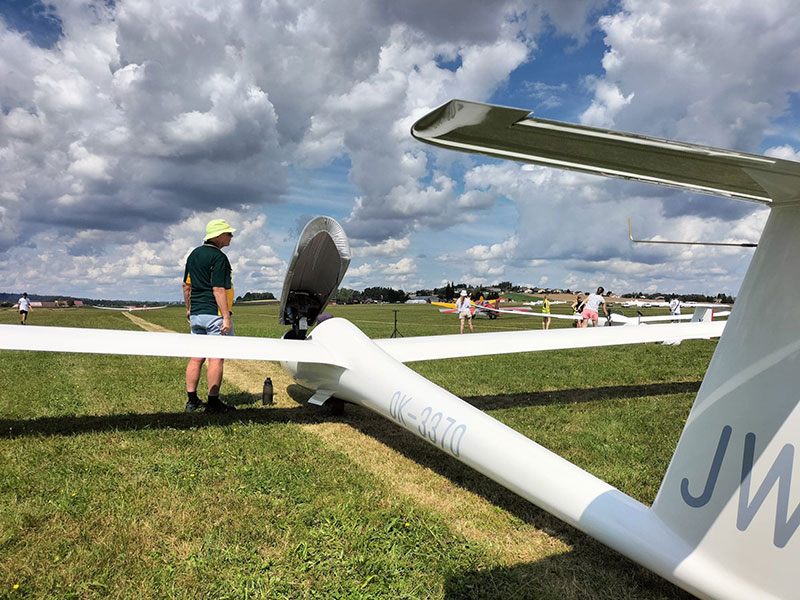
Day 11 was relatively uneventful. Henry and I worked well together in strong cumulus conditions to assemble a flight good enough for 9th place. However, it was the beginning of the end for Henry, who finally fell to the severe gastro attack that had been sweeping through the British camp. He was unfortunately off to hospital for monitoring and was out of the competition.
The final competition day dawned, and I was humbled to be invited on to the British Gliding Team frequency to exchange information with Finn and Toby, who were looking to secure the world title in Club Class. This information was potentially very useful for both parties, since the directions of the day’s assigned area tasks were opposite for the two classes. I elected to fly with the local Czech team for some additional coverage, expecting that they would be full of motivation to secure 2nd and 3rd place overall. Unfortunately, the three of us had a low point in the first sector, and our day unravelled following the scare that this was to them.
While already having a terribly slow day, we were confronted with a genuinely wiped-out final sector of the final task of a world comp. Some cumulonimbus had overdeveloped and started dumping to the extent that access to the back of the sector following a very long excursion was barely achievable. Because we were running late, our access to the sector was even worse than our fellow competitors who had run through 10 minutes earlier. Any gliders behind us found themselves landing in very wet fields. I eventually flew home to an underwhelming 17th place for the day, which saw me slip down to 15th overall. It was a disappointing way to bookend what was a disappointing and character-building competition.
Signing Off
I would like to extend a huge thank you to our Team Captain, Russell Edwards, for his commitment and efforts throughout the entire campaign. Russell worked with us through it all - from licensing, medicals and glider swaps, through to the good days, the bad days and, of course, the incident. In every case, he was a huge resource and took everything in his stride. Thank you, Russ.
Our crews were ever committed and resourceful. Noah Tanzen did a fantastic job crewing for Ryan, showing maturity and capability well beyond his years. My guys – Joe O’Donnell and Andy Horton – were a delight to work with and rode the bumps with me like legends. I truly cannot thank them enough for their efforts.
The GFA membership all contribute funds for international teams to represent them in these events, and while the expense of the paperwork, travel, administration and surviving the ordeal is vast, the funding contributes to this exercise and is appreciated immensely. In return I hope that the information and new techniques gained by having Ryan and I attend the competition are communicated and retained within the gliding community. Competition at this level is critical to our continued progress as a sport here in Australia, and I would like to thank each and every one of you for your contribution. 
James gets some advice while waiting to launch.
12th Junior World Gliding Championships
Tábor Czech Republic 30 July – 12 August 2022
Standard Class
1 Simon Briel Discus 2 Germany 8,068
2 Lukas Kriz LS8 Czechia 7,660
3 Jaromir Macoun LS8 Czechia 7,633
15 James Nugent LS8 Australiap 7,102
Full results at soaringspot.com
bit.ly/3JWKqAI































